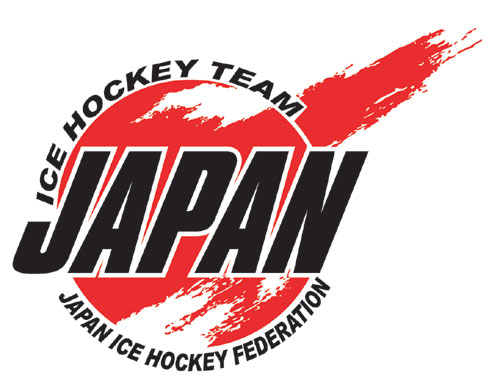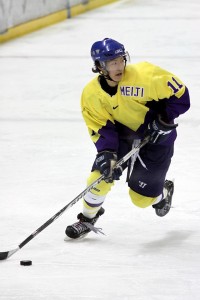
If someone was to predict that Japan was going to be one of the best teams at any of the World Junior tournaments this year, that person would probably be laughed at. For a country that has sent only one native-born and trained player to the NHL, it is unbelievable to postulate any success whatsoever, especially when one looks at a roster filled with mostly national university players, two high school students and only one who plays somewhere other than his homeland. (Forward Yuto Osawa, the team’s captain, plays for Mora IK J20 in Sweden.) At the 2013 Division 2A World Juniors, Japan shocked everyone by having one of the greatest runs of any team in recent memory of the tournament, all en route to winning their second World Junior gold medal in five years and their third since 2005.
The first thing one could notice from looking at the roster for Japan at the 2013 World Juniors — which were held in Brașov, Romania — is how inexperienced they were. Out of their 22-man team, all but four were 1993-born players, making them one of the older squads in their tournament, which also featured Hungary, Lithuania, the Netherlands, Romania and Spain; many players, however, had been in only one IIHF tournament before. (One of their players, forward Yushiroh Hirano, was a 1995-born player.) In addition to that overwhelming inexperience, one thing that could have worked against them was their size. The three tallest players on the roster — goaltender Shun Hitomi, forward Kenta Takagi and defenceman Jun Hashimoto — were only six feet tall apiece. The shortest player, forward Hiroyoshi Umeno, was only 5’4″, making him the shortest player in the tournament. Like many Japanese, too, this team was sleight to say the least. Takagi and Osawa were the heaviest at 194 pounds each, while the lightest player was 143-pound goalie Yuya Wakimoto.
Japan could have easily rolled over and let the other teams play over them but they were not going to go down without a fight.
*

In their first game of the 2013 World Juniors on December 9th, Japan faced Hungary. Kosuke Otsu made it 1-0 for Japan only four minutes in on the power play but Hungary tied the game with a goal of their own only 97 seconds later. The Hungarians eventually led 2-1 after two periods. Japan was about to open the floodgates in the third period. They scored six unanswered goals in the final twenty minutes of play, all within eleven minutes and twelve seconds. Two were scored by Yuto Osawa (who was named player of the game), while singles were scored by Shun Tateda, Shogo Nakajima and twin brothers Ryota and Kazuki Sarashiya. Four of the goals were scored on the man advantage. Hitomi made 29 saves for the victory.
In their second game on December 10th, Japan faced Spain. The Spanish tried their best to instill some fear into their opponent, scoring only 27 seconds into the first period. Japan was undeterred. Nakajima scored his second goal of the tournament to tie the game at 1-1 only 25 seconds later. At 5:48 of the first period, Takahiro Ishikawa scored to put Japan ahead 2-1. Just like against Hungary in their first game, Japan then decided to bombard their opposition. Otsu, Yuto Osawa, Hiroto Sato and Yoshiya Yokoyama all scored in the second period, the four goals coming within twelve and a half minutes. Three of the four goals were on the power play, including one scored on a five-on-three advantage. Japan’s defence also truly aided Yuya Wakimoto, who only faced thirteen shots from the Spanish, as opposed to the 51 fired at both of their opponents’ goalies. Otsu was named player of the game for Japan.

In their third game on December 12th, Japan faced the Netherlands. Just like in their game against Spain, Japan gave up the first goal. The Dutch carried that 1-0 lead into the dressing room after one period. Japan, however, did what they had done for the entire tournament up to then: Score goals in bunches. They scored four even-strength goals in the second frame, two coming from Makuru Furuhashi and singles from Yuto Osawa and Kazuki Sarashiya. Those goals also came in rapid succession, too, coming in only a span of ten minutes and thirteen seconds. In the third period, Japan truly took it to the Dutch, scoring four more goals in twelve minutes and 45 seconds. Sato, Ishikawa, Kenta Takagi and Kakeru Osawa all tallied for Japan in that period, who fired a total of 50 shots at the Nederlander goalies while their opponents only mustered fourteen shots on Shun Hitomi. Furuhashi was named player of the game for Japan.
In their fourth game on December 13th, Japan faced Romania, the host team. Yoshiya Yokoyama got the opening goal of the game, scoring at 15:36 of the first period. Romania tied the game in the second at 8:53 of the middle frame. Japan made sure that the Romanians could not get any good shots on Hitomi all game long. In the third period, Japan took over, scoring three goals in ten minutes and nineteen seconds. Nakajima, Sato and Kazuki Sarashiya all tallied to put the game away. Hitomi made fourteen saves for the win. The win sealed gold for Japan but they still had one last game.
In their fifth and final game on December 15th, Japan faced Lithuania. Just like in their games against Spain and the Netherlands, Japan gave up the first goal. With five seconds left in the first period, though, Jun Hashimoto — who was in the penalty box when Lithuania scored their goal, scored his first of the tournament, allowing for his team to be tied at the end of the period rather than be down 1-0. In the second period, Japan got goals only two minutes and 48 seconds apart from Nakajima and Kazuki Sarashiya to make it 3-1. The Lithuanians, however, would not go away; at 9:13 of the middle stanza, they scored to make it 3-2. Lithuania then truly gave Japan a scare in the third period, tying the game at 3-3 only 1:58 into the final frame. Almost exactly four minutes later, Takagi scored to give Japan a 4-3 lead and they never trailed again after that. At 18:51, Yuto Osawa scored to make it 5-3. Since it was the last shift of the tournament, Japan put out their fourth line — Tomonori Kanemura, Mikihisa Kitajima and Maito Omuku — and they managed to get a goal of their own; Kanemura scored the goal that made it 6-3 with only sixteen seconds remaining in regulation, his only goal of the tournament, with Kitajima and Omuku assisting. Wakamoto made only ten saves in the victory.
*
If all of this was not impressive enough for Japan, other statistics made it even clearer. They led the tournament with 183 shots on goal, 25 of which found the back of the net, and their 13.66% shot-goal percentage was second only to Romania. Japan led the World Juniors with an incredible eleven power play goals on 26 opportunities, good enough for a 42.31% power play percentage. Additionally, they had an 89.47% penalty kill percentage, only allowing two power play goals in the entire tournament, those being a pair of the three goals scored by Lithuania in the tournament finale. Their 73 goals against was the lowest in the tournament, allowing them to lead the World Juniors with a collective 1.25 goals-against average and a 93.15% save percentage. The scoring was so evenly distributed that every player on Japan’s roster, except for the two goalies, had at least one point during the tournament.
For his solid play, Hiroto Sato was named by the directorate as the top defenceman. Four players — Shogo Nakijama, Makuru Furuhashi, Yuto Osawa and Kenta Takagi — finished in the top ten in tournament scoring. The captain also led the tournament with a 69.15% faceoff winning percentage, allowing for the coaches to name him Japan’s best player. Furuhashi co-led the tournament with a +7 ranking and also led the tournament with 25 shots on goal, meaning that he averaged five shots per game. Shun Hitomi led the tournament with both a 1.33 goals-against average and a .933% save percentage.
Another key reason for the success Japan had could be attributed to their coach. A native of Vankleek Hill, Ontario, Mark Mahon has been the head coach of the Japanese national men’s hockey team since the 2004 World Championships. He also has been the coach of the national junior team since 2011, both at the World Juniors and at the under-20 Challenge Cup of Asia. As a player, Mahon spent the majority of his ten-year professional career playing in Germany, a tenure that came after three years in the OUA with the Concordia University Stingers. Players Mahon has helped mould over the years include Go Tanaka and Shunsuke Shigeno, as well as — most notably — Yutaka Fukufuji, the first Japanese-born and trained player to ever appear in an NHL game, and Hiroyuki Miura, the first Japanese player ever drafted to the NHL.
Because of how well they performed at this year’s World Junior tournament, Japan will now be promoted to the 2014 Division 1B IIHF World Junior Championships. It is not known at this time where that tournament will be held, though. The majority of the players who helped this team win gold will not be returning but there is a good possibility that they will still remain competitive, perhaps shocking just as many people as they did this year.